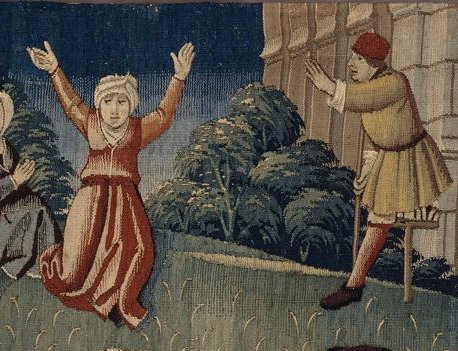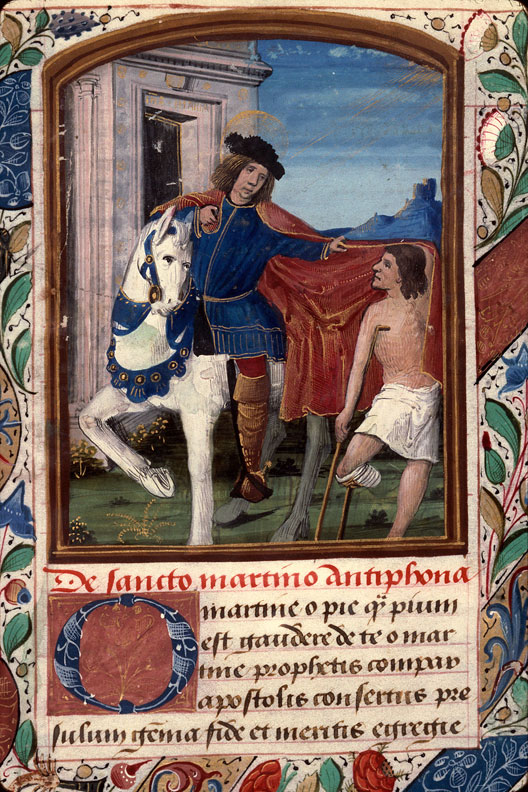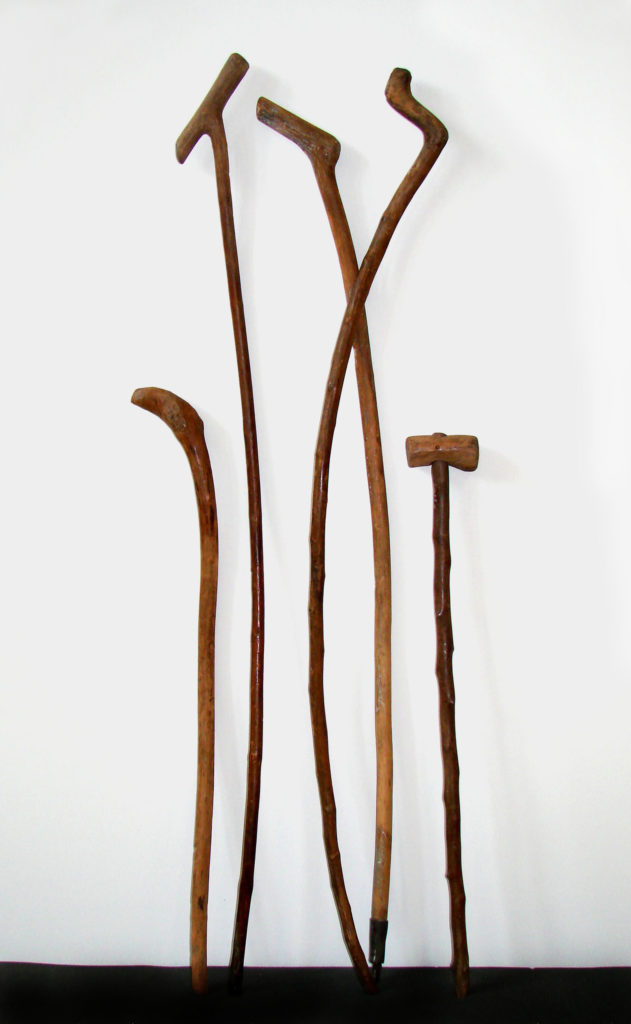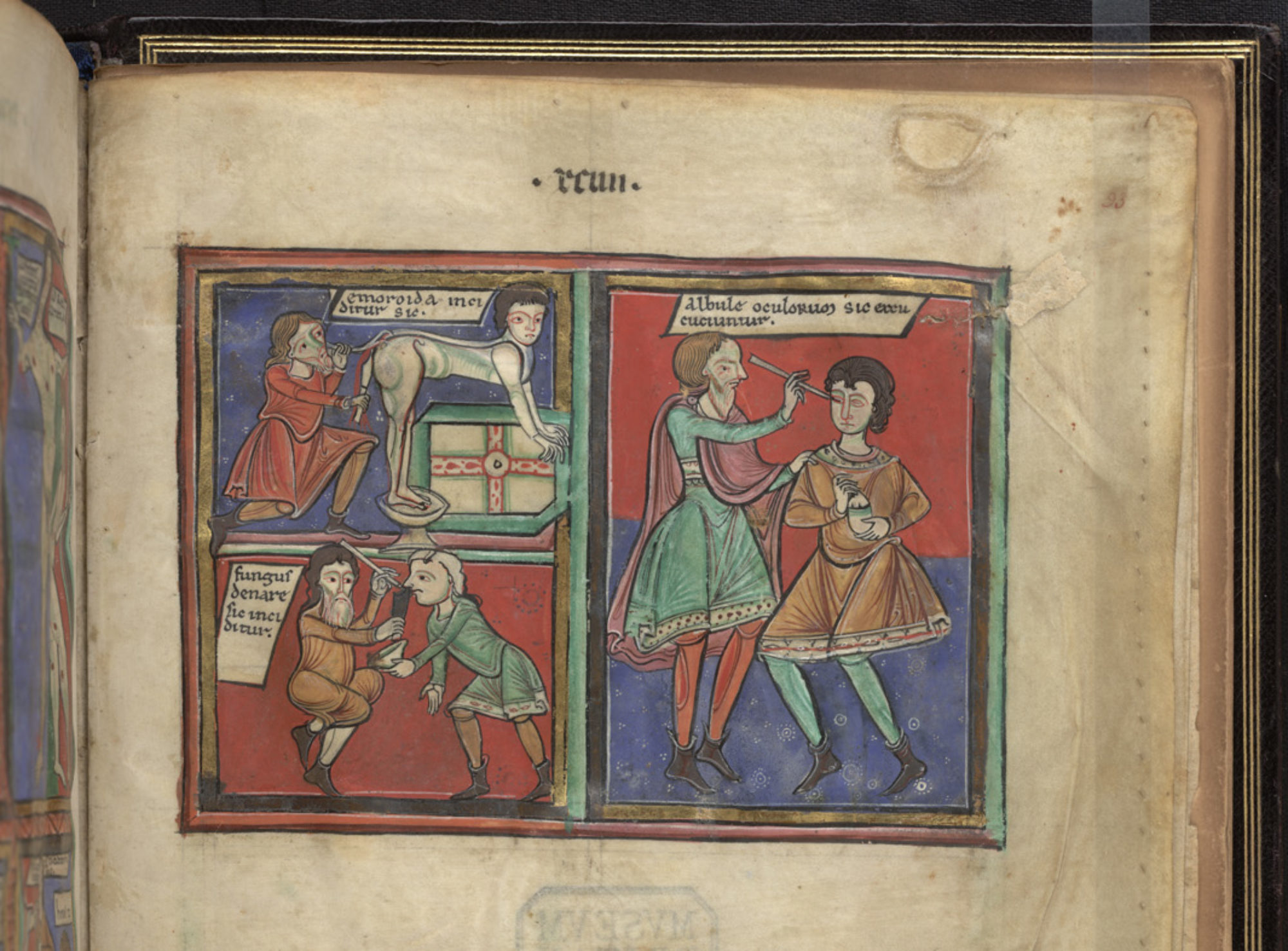The text was read during the American Historical Association Conference 2024 (5-6 January 2024, San Francisco)
Presidential session 220A. New Directions in the History of Premodern Disability (Hilton Union Square, Continental Ballroom 3)
Chair:
- Edward Muir, Northwestern University
Panel:
- Haley Elisabeth Bowen, Northwestern University
- Laurel Daen, University of Notre Dame
- Ninon Dubourg, Fonds de la Recherche Scientifique
- Christopher Gabbard, University of North Florida
Material History of Premodern Disability
An Interdisciplinary History of Mobility Aids in the Medieval Period
State of the art
[PPT 2] Disabled people are everywhere in history if only we look for them. Yet, as Douglas C. Baynton observed in 2001, disabled people remain “conspicuously absent in the histories we write”. Since then, however, there have been tectonic shifts in the scholarly approach to disability history, establishing the field as fertile ground for urgent interdisciplinary analysis.
[PPT 3] As Irina Metzler argued in 2006, Disability is a polysemous concept. This notion is both synchronic (revealing structures, ideas, or cultures that exist today) and diachronic (mobilizing concepts or structures that evolve over time). It has become a crucial heuristic tool in the investigation of oppression and is used as a potent analytical approach in many disciplines. Historians—notably, though not exclusively, medievalists—have seized on disability as a means to probe in depth the socio-cultural nuances of the period under study.
As conceptualised by Catherine Kudlick in 2003: disability encompasses economic, social, political, cultural, religious, legal, philosophical, artistic, moral, and medical definitions. This expansiveness is key to its methodological potency, yet it also compels historians to thoroughly contextualize the concept before deploying it as an analytical tool. Disability is a cultural construct, without a fixed definition. Its precise meaning changes depending on the area and temporal era in which it is encountered. The meaning of disability also varies according to the more immediate social or environmental context in which it is encountered. Its definition can thus change according to the documents studied.
[PPT 4] At the beginning, studies in the field of medieval history tend to focus on the conceptualization of disability but often fail to probe disabled people’s real-life experiences. However, a significant conceptual shift has gained ground in the past decade or so, with disability now understood as that which diverges from culturally constituted “norms” at a given moment in time, a socio-cultural phenomenon. Consequently, authentic experiences of premodern disability may be uncovered if the historian, anthropologist, or sociologist succeeds in understanding the endogenous categorization of disabled people in a given period and society, and in determining what experiences came together under its banner.
Recently, several publications have tried to better delimit the field of research with the aim of contributing to a deeper understanding of disability in premodern times. This strand of research foregrounds the intersectional nature of disability, the ways in which all individuals are enmeshed in overlapping matrices of domination based on the specificities of their identities—not just disability, but age, gender, social status, and so on. In other words, disability is not lived in a vacuum; an individual’s experience of disability varies according to the other identity nodes they inhabit.
In the past two decades, academics have begun to demonstrate in ever finer detail that the meaning, and thus lived experiences, of disability change over time, and within and between cultures. Recent studies focus on particular groups of disabled people, such as children, “mad” people, saints, and clerics. In fact, paying attention to the experiences of multiple marginalized people in the past can change our understanding of society as a whole. As a result, more and more historical publications are now pursuing an intersectional approach to thinking about disability as a category of analysis, forcing us to rethink what we hold to be fundamental principles of life in the Middle Ages.
Future directions
[PPT 5] As a young researcher, I try to think about the next chapter of the discipline. This entails not only the pursuit of fresh lines of inquiry but also an ongoing commitment to making disability history relevant and accessible to its key stakeholders, the modern disability community. This is why I wish to develop the material history of medieval disability, a topic heretofore almost entirely overlooked in scholarship, and produce new insights about medieval disabled people’s lived experiences through a study of mobility aids.
What do we mean when we talk about the “material history” of disability? Material culture is the study of the social reality that “things” afford, including their creation and usage but also the norms, rituals, and behaviors associated with them, alongside their conservation, preservation, and display.
It draws on questions and methods from the “material turn” that emerged in the 1980s and 90s. The discipline of material culture emerged from the twinned fields of anthropology and ethnography and had an impact on studies in history, art history, and archaeology, with a multidisciplinary approach. Embracing material culture allows historians to enrich their toolkit: the consideration of “things” (artifacts, objects) as historical evidence alongside more traditional sources is fundamentally productive, integrating interdisciplinarity within the historical method.
It is only recently that contemporary disability history has begun to take an interest in material culture, either in theory or more literally, with the study of assistive technologies, such as 19th-century prosthetics, 19th-century hearing aids, or assistive devices in the US from 1700 onwards.
[PPT 6] A handful of extant studies consider disability-related objects in the premodern period. Some use the medieval period only for basic context and, so doing, propose only generalities. Others offer only a brief inventory of a small number of relevant images from the Middle Ages, without providing historical analysis or contextualization. Other studies lay the general groundwork for more specialized, comprehensive research in the field.
The creation of a material history of medieval mobility aids necessitates a cross-disciplinary, comprehensively comparative approach, thanks to the wealth of potential sources and avenues of inquiry.
Case study
[PPT 7] The case study I have chosen to present today concerns Brother Jean Fanigonoset de Rabbonne, a cleric from the monastery of Saint Pierre d’Estival in the diocese of Toul whose case was dealt with on February 12, 1492. I found this letter in the Apostolic Penitentiary registers, preserved in the Vatican Archives, which gather thousands of requests made by laypeople and clerics who wrote to the Popes to ask for pontifical pardon, in the form of absolutions, indulgences, dispensations, and licenses. Those letters contain the requests made by people from all over Europe and, then, by the verdict handed down by the penitentiaries, who handled these cases by delegation from the papal authorities.
This specific letter, which will now be read in full, has been translated directly from Latin.
Professed brother Jean Fanigonoset de Rabbonne, cleric in the diocese of Toul, Estivagio [Saint Pierre d’Estival] monastery of the Premonstratensians order in the aforesaid diocese, who, out of great fervor of devotion, desired to become cleric and was promoted to all the sacred orders and the priesthood[. A]fter he has been promoted, he minister in the ministry of the altar and engage himself with great piety in the perpetual divine service in the said monastery.
But while he was away from the monastery to devote himself to this [task], a certain illness (infirmitas) occurred in his right tibia, as a result of which, with the consent of the doctors, and because of the state of his body, he had the tibia amputated up to the knee; and then, with God’s permission, he was freed from this illness and recovered his health.
Apostolic Penitentiary, Registrum Matrimonium et diversorum, Vol. 41, fol. 187v-188r. February 12, 1492. Diocese of Toul.
[PPT 8] He has artificially made a kind of wooden instrument with which he can travel well on his other joints, and can leave the monastery insofar as his tibia does not have such a great defect or deformity that can generate scandal among the people, or an impediment that prevents him from making Mass.
He therefore humbly begs Your Holiness to kindly dispense with him by a special and express grace, to the extent that he may remain a cleric despite the defects and deformities mentioned, and retain his promotion to all sacred orders and the presbyterate, having been promoted previously, and that he may freely and lawfully minister in the ministry of the altar or be a canon.
Made especially and expressly provided that he could rest his chin on the piece of wood when ministering at the altar.
Analysis
[PPT 9] Jean’s device might have looked exactly like the one represented here, a random character taken from the Tapestries from the History of Saint-Etienne (1500-1509), now preserved in the Musée de Cluny, in Paris. This depiction demonstrates that the authors and artists are used to seeing in their daily lives and shows how these kinds of assistive devices could have been used in their context. This “piece of wood” is used in combination with a walking stick when moving in this example, and it might have been also the case for Jean. But that was not the movement that was a source of worry for the Apostolic Penitentiary, but Jean’s possibility of standing still and doing the Mass.

Tapestries from the History of Saint-Etienne (1500-1509), Musée de Cluny (Paris), my photography.
The problem here is that the mutilation leads to a deformity, a defect (of the body). The defectus corporis is the legal category contained in canon law that prevents someone from becoming ordained, but which, thanks to 12th and 13th centuries pontifical decrees, does not prevent a cleric already ordained from fulfilling his tasks, on 2 conditions exposed in the letter: Jean explain that he stays able (to travel, to say Mass while standing), and does not inspire scandal to his parishioners.
By stating those two facts, Jean shows that he is conscious of what is important for the Apostolic Penitentiary. On one hand, impairment’s consequences on the body were the principal matter of the papal dispensation letters about physical disability. Incapacity affects a person’s profession, whatever it may be, which he or she can no longer carry out without support. Then, the Chancery’s goal was to define whether or not the clerics could accomplish their duty. The Church’s argument behind that was to prevent any spiritual or temporal damages to its own affairs, then ensure that the cleric was still taking care of the spiritual matters of his benefice and that its goods were well managed. Incapacity is therefore linked to the nature of the acts to be performed. It is defined by the meaning given by the community to the tasks that the applicant must fulfill and by his ability to succeed.
But this letter also shows that it is sometimes possible to compete with those physical standards. Here, Jean is facing himself with crip time. Indeed, the decree at the end of the letter specifically asks that he use his device while ministering. Crip time is an extension of crip theory, a critical lens that emphasizes how social norms and pressures shape the meaning, and experience, of ability and disability. “Crip time” refers to how neurodivergent and physically disabled people experience time and space differently than their non-disabled counterparts who live in “normative time”. Mobility aids in particular are not used by people at all times in their lives, nor on all occasions, depending for example on peaks of pain or fatigue. When people are at home, or if they do not have to travel very far, they may not need their aids. In John’s instance, the mobility aid allows crip time itself to become perceptible.
[PPT 10] On another hand, the other crucial criterion for the Pope’s representatives is the cleric’s representation in front of the faithful. In theory, a priest should be exemplary in his dealings with the faithful, but a physical imperfection could tarnish his reputation, undermine social peace, and lead to scandal. The role of the Church was to maintain the cleric’s deficiency unknown to the parishioners, using dispensation letters, when possible, which is not the case here as Jean has to use a mobility aid.
Moreover, mobility aids enable their users, rendering their disability visible to their physical and social environments. Indeed, a mobility aid is the material manifestation of its user’s “deviation” from physical “norms”. In a seated setting, for example, an individual with a mobility impairment can “pass” as non-disabled. When they get up and reach for their cane, their disability is made public, and visible to all. Then Jean may face rejection by the Christian community as his body could cause a social stigmatization.
Often, mobility aids help to characterize unambiguously the pictured individuals for viewers, as people seeking miraculous healing or begging for alms. This is what is represented here some years apart from this letter, with St Martin giving part of his coat to a (disabled) poor. This is because the depicted mobility aids function as identity markers. Notionally “incidental” details thus offer valuable information not just about the artist’s attitudes but also the text’s author, its commissioners, and intended readers/viewers.

Heures à l’usage de Langres (1475-1500), Langres, BM 0004 (0030), fol. 149.
[PPT 11] But this letter can also be studied for the information it contains about the materiality of the objects. We learn here that the artificial limb was custom-made. If John may have designed his instrument on his own, he undoubtedly needed the help of a Carpenter to finish his work. A testimony from Guillaume de St Pathus’ Miracles de Saint Louis written more than 180 years ago recounts:
Robert Reboule li conseilla que il se feist couper le pié et fere une eschace de fust, si que il peust miex estre curé et estre entre les genz a gaaignier son pain. Et donques ledit Guillot ala au charpentier et li raconta que il entendoit a fere.
(Robert Reboule advised him to have his foot cut off and to make an axe, so that he could better be cared for and be among the people to earn his bread. And so the said Guillot went to the carpenter and told him what he intended to do.)
Guillaume de St Pathus’ Miracles de saint Louis [around 1310, VII-68] (in G. de Saint-Pathus, Les Miracles de Saint-Louis, ed. by P. B. Fay, Honoré Champion, 1932, p. 24).
Although I haven’t yet found any more information on Jean and his story, we can assume that his case and the concomitant clues tell us a lot about the use and role of mobility aids in the late medieval period.
Conclusions
[PPT 12] The goal of this presentation was to demonstrate how this kind of practical text can reveal what mobility aids were, and then usefully stand in for the physical objects themselves, which are rarely preserved. Exceptions like those canes found in the inventory of St. Anne’s Hospital (13-16 c.), in the city of Magdeburg (Germany) are rare. This speech also advocates for the potential for such “things” to shape an individual’s personal and social relation to disability in the pre-modern periods. Indeed, the source’s intrinsic contribution to the study of the material culture of disability emerges from a contextual analysis of the cultural and social signification of a given object that other sources will help to develop. How mobility aids augmented embodiment in the Middle Ages, and the social and cultural implications of this process, must be subject to further interrogation.

Photography courtesy of Dr Simone Kahlow.
Moreover, a better knowledge of those objects might help with the restoration of disability heritage. Disabled people, like all those with marginalized identities—racialized people, gender-non-conforming people, women, etc.—have been deprived of their heritage by cultural institutions that too often center the representation on dominant groups in exhibitions, or appeal to such groups’ interests in selecting items to display. Objects produced by or representing non-dominant groups were routinely discarded by Victorian curators, deemed to be of insufficient cultural value to be preserved in collections.
Things are, thankfully, changing. There is an evident push to bring greater visibility to objects relating to traditionally marginalized groups in material culture studies and to highlight how accessibility enhances cultural heritage. Nevertheless, this vital process has only just begun. Disability heritage remains deprioritized within relevant debates, and contextualization is still sorely lacking.
Download text and PDF here:
